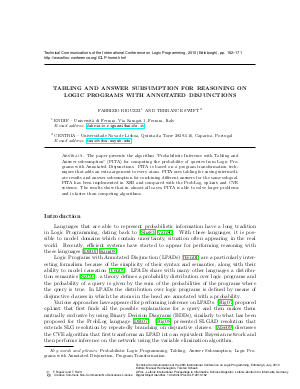Tabling and Answer Subsumption for Reasoning on Logic Programs with Annotated Disjunctions
Authors Fabrizio Riguzzi, Terrance Swift
-
Part of:
Volume:
Technical Communications of the 26th International Conference on Logic Programming (ICLP 2010)
Part of: Series: Leibniz International Proceedings in Informatics (LIPIcs)
Part of: Conference: International Conference on Logic Programming (ICLP) - License:
 Creative Commons Attribution-NonCommercial-NoDerivs 3.0 Unported license
Creative Commons Attribution-NonCommercial-NoDerivs 3.0 Unported license
- Publication Date: 2010-06-25
File

PDF
LIPIcs.ICLP.2010.162.pdf
- Filesize: 0.58 MB
- 10 pages
Document Identifiers
Subject Classification
Keywords
- Probabilistic Logic Programming
- Tabling
- Answer Subsumption
- Logic Programs with Annotated Disjunction
- Program Transformation
Metrics
- Access Statistics
-
Total Accesses (updated on a weekly basis)
0Document
0Metadata
Abstract
The paper presents the algorithm "Probabilistic Inference with Tabling and Answer subsumption" (PITA) for computing the probability of queries from Logic Programs with Annotated Disjunctions. PITA is based on a program transformation techniques that adds an extra argument to every atom. PITA uses tabling for saving intermediate results and answer subsumption for combining different answers for the same subgoal. PITA has been implemented in XSB and compared with the ProbLog, cplint and CVE systems. The results show that in almost all cases, PITA is able to solve larger problems and is faster than competing algorithms.
Cite As Get BibTex
Fabrizio Riguzzi and Terrance Swift. Tabling and Answer Subsumption for Reasoning on Logic Programs with Annotated Disjunctions. In Technical Communications of the 26th International Conference on Logic Programming. Leibniz International Proceedings in Informatics (LIPIcs), Volume 7, pp. 162-171, Schloss Dagstuhl – Leibniz-Zentrum für Informatik (2010)
https://doi.org/10.4230/LIPIcs.ICLP.2010.162
BibTex
@InProceedings{riguzzi_et_al:LIPIcs.ICLP.2010.162,
author = {Riguzzi, Fabrizio and Swift, Terrance},
title = {{Tabling and Answer Subsumption for Reasoning on Logic Programs with Annotated Disjunctions}},
booktitle = {Technical Communications of the 26th International Conference on Logic Programming},
pages = {162--171},
series = {Leibniz International Proceedings in Informatics (LIPIcs)},
ISBN = {978-3-939897-17-0},
ISSN = {1868-8969},
year = {2010},
volume = {7},
editor = {Hermenegildo, Manuel and Schaub, Torsten},
publisher = {Schloss Dagstuhl -- Leibniz-Zentrum f{\"u}r Informatik},
address = {Dagstuhl, Germany},
URL = {https://drops.dagstuhl.de/entities/document/10.4230/LIPIcs.ICLP.2010.162},
URN = {urn:nbn:de:0030-drops-25948},
doi = {10.4230/LIPIcs.ICLP.2010.162},
annote = {Keywords: Probabilistic Logic Programming, Tabling, Answer Subsumption, Logic Programs with Annotated Disjunction, Program Transformation}
}
